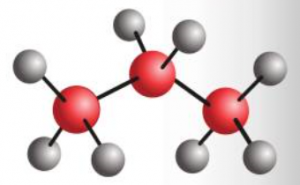Electronic Chemicals
______
Germanes are widely used in the chemical vapor deposition (CVD) of materials containing germanium and devices for the fabrication of the semiconductor chips in group IV microelectronic and optoeletronic technologies. Heteroepitaxial Ge1-xSix layers on Si (100) are used in many applications in key technologies such as MEMS, quantum cascade lasers and Si-based photonics including high speed modulators and photodetectors. Other uses of germane include thin film amorphous silicon solar cells.
Germane
______
Germane Gas (GeH4)
- CAS Number: 7782-65-2
- EINECS Number: 231-961-6
- Boiling Point: -88°C
- Melting Point: -165°C
- Molecular Weight: 76.62 g/mol
- Density: 3.3 g/liter
- HMIS Key: 4-4-3-X
- Hydrolytic Sensitivity: 10: reacts extremely rapidly with moisture and oxygen - may be pyrophoric - sealed system required
- Purity: 99.999%
Application:
The gas decomposes near 330°C to germanium and hydrogen. Because of its thermal lability, germane is used in the semiconductor industry for the epitaxial growth of germanium by MOVPE or chemical beam epitaxy.
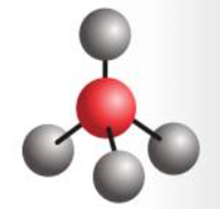
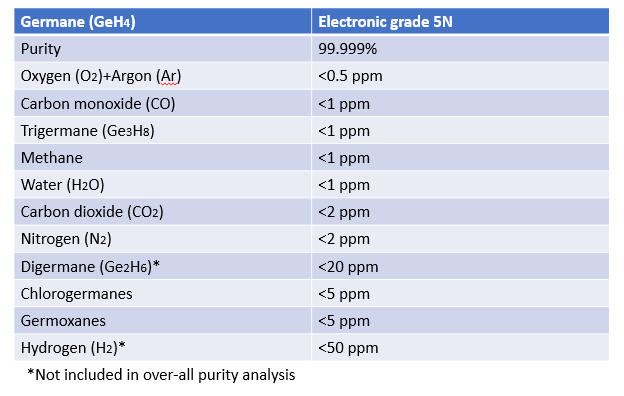
Digermane
______
Digermane (Ge2H6)
- CAS Number: 7782-65-2
- Boiling Point: 31.5°C
- Melting Point: -109°C
- Molecular Weight: 151.33 g/mol
- Density: 1.70 g/cc
- Hydrolytic Sensitivity: 10: reacts extremely rapidly with moisture and oxygen - may be pyrophoric - sealed system required
- Purity: 99.99%
Application:
Digermane is used for the deposition of amorphous and epitaxial germanium thin films. Digermane is also used in the formation of boron-doped SiGe alloy layers and with diborane in the formation of B-doped Ge(001) films, both by gas-source molecular-beam epitaxy (MBE). Precursor to Ge and Ge-Si alloy thin films.
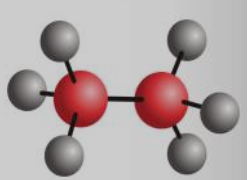
Trigermane
______
Trigermane (Ge3H8)
- CAS number: 14691-44-2
- Boiling Point: 110.5°C
- Melting Point: -105.6°C
- Molecular Weight: 225.95 g/mol
- Density: 2.2 g/cc
- Hydrolytic Sensitivity: 10: reacts extremely rapidly with moisture and oxygen - may be pyrophoric - sealed system required
- Purity: 99.99%
Application:
Trigermane is used for the deposition of amorphous and epitaxial germanium thin films. The use of trigermane decreases the deposition temperature and increasing the deposition rate.
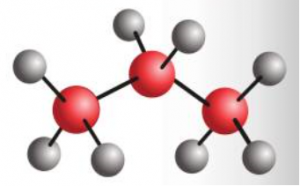
Disilane
______
Disilane (Si2H6)
- CAS No.: 1590-87-0
- EC No.: 216-466-5
- Boiling Point: -14°C
- Melting Point: -132°C
- Molecular Weight: 62.22 g/mol
- Density: 2.7 g/litre
- Hydrolytic Sensitivity: 10: reacts extremely rapidly with moisture and oxygen - pyrophoric - sealed system required
- Purity: 99.99%
Application:
Precursor for the rapid, low temperature deposition of epitaxial silicon and silicon-based dielectrics. Disilane is used for the deposition of amorphous silicon, epitaxial silicon and silicon based dielectrics via rapid low-temperature chemical vapor depsition (LTCVD). Disilane is also used in the epitaxial growth of SiGe films by molecular beam epitaxy (MBE) in conjunction with solid sources of germanium. Precursor for the rapid, low temperature deposition of epitaxial silicon and silicon-based dielectrics.
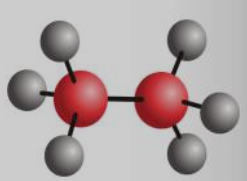
Trisilane
______
Trisilane (Si3H8)
- CAS No.: 7783-26-8
- Boiling Point: 52.9°C
- Melting Point: -117°C
- Molecular Weight: 92.32 g/mol
- Density: 0.734 g/cc
- Hydrolytic Sensitivity: 10: reacts extremely rapidly with moisture and oxygen - may be pyrophoric - sealed system required
- Purity: 99.99%
Application:
Trisilane is used for the deposition of amorphous silicon, epitaxial silicon and silicon based dielectrics via rapid low-temperature chemical vapor depsition (LTCVD). Disilane is also used in the epitaxial growth of SiGe films by molecular beam epitaxy (MBE) in conjunction with solid sources of germanium. Precursor for the rapid, low temperature deposition of epitaxial silicon and silicon-based dielectrics.
